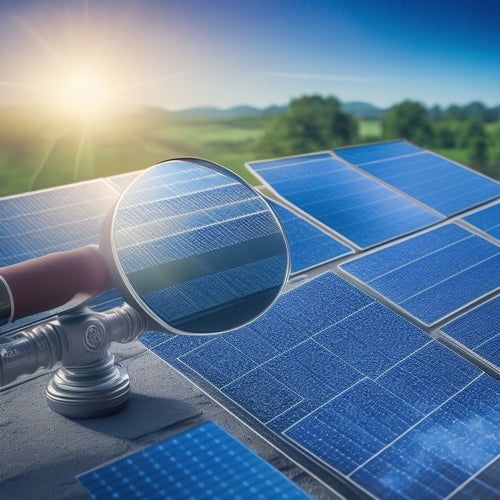
Do You Know These 10 Essential Tips to Maximize Your Portable Solar Panels
Share
To maximize your portable solar panels, you should adjust the panel angle to match the sun's angle, prioritize a high-efficiency charge controller, and track your battery's charge cycles. Regularly calibrate the panel angle for seasonal changes and assess the surroundings for ideal sunlight exposure. Add to that, choosing high-quality, outdoor-resistant cables and a high-quality inverter minimizes energy loss. By following these essential tips, you'll be on your way to optimizing your portable solar panels. Now, discover more ways to unleash their full potential.
Key Takeaways
• Adjust the solar panel angle to match the sun's angle, and consider solar tracking to boost energy harvesting by up to 40%.
• Choose high-efficiency equipment, including a charge controller and inverter, to minimize energy loss and ensure compatibility.
• Properly manage your battery by tracking charge cycles, avoiding deep discharges, and monitoring capacity to prevent potential issues.
• Ensure proper cabling by selecting the right wire gauge, rating, and materials to prevent energy loss and damage.
• Store your solar panels and batteries in a clean, dry environment, protected from physical damage and extreme temperatures.
Optimize Your Panel's Angle
When positioning your portable solar panel, adjust its angle to match the current sun angle, as this optimization can boost energy harvesting by up to 40%.
This process, known as solar tracking, guarantees your panel is aligned with the sun's trajectory, maximizing energy output.
To achieve peak performance, regularly calibrate your panel's angle to account for seasonal changes in the sun's position.
During summer months, the sun is higher in the sky, requiring a more vertical angle, while winter months require a more horizontal angle.
Proper angle calibration is vital, as a misaligned panel can greatly reduce energy output.
Invest in an adjustable mounting system, allowing you to fine-tune your panel's angle throughout the year.
By doing so, you'll ensure your portable solar panel operates at its best efficiency, providing reliable power for your devices.
Choose the Right Charge Controller
With your portable solar panel optimized for maximum energy harvesting, it's time to focus on regulating the flow of energy to your devices, which is where a high-quality charge controller comes in. As you explore your options, prioritize controller efficiency to minimize energy loss. A high-efficiency charge controller guarantees that most of the energy generated by your solar panel is effectively utilized by your devices.
When selecting a charge controller, consider solar compatibility to guarantee seamless integration with your portable solar panel. Look for controllers with a high maximum power point tracking (MPPT) rating, which optimizes energy harvesting by adapting to changing solar conditions. Additionally, consider the controller's compatibility with your device's voltage and current requirements.
A suitable charge controller should also provide overcharge protection, preventing damage to your devices and prolonging their lifespan. By choosing the right charge controller, you'll be able to efficiently harness the energy generated by your portable solar panel, powering your devices reliably and efficiently.
Monitor Your Battery Health
When you're using portable solar panels, it's important to keep a close eye on your battery's health. You'll want to monitor its charge cycles, track its capacity, and avoid deep discharging to guarantee peak performance.
Battery Charge Cycles
You should track your battery's charge cycles to monitor its health and optimize its lifespan, as a deep cycle battery typically lasts for around 300 to 500 charge cycles. Keeping a close eye on cycle counting is important for prolonging your battery's lifespan.
Here are some key considerations to keep in mind:
-
Understand cycle counting: Each time your battery is discharged and recharged, it counts as one cycle. Monitoring cycle count helps you estimate your battery's remaining lifespan.
-
Know your battery type: Different battery types have varying lifespans. For example, a deep cycle battery typically lasts for around 300 to 500 charge cycles, while a lithium-ion battery can last up to 1,000 cycles.
-
Avoid deep discharges: Deep discharging can significantly reduce your battery's lifespan. Try to keep your battery level between 20% and 80% charged to minimize wear and tear.
- Store your battery properly: When not in use, store your battery in a cool, dry place, away from metal objects, to prevent damage and prolong its lifespan.
Track Battery Capacity
Monitoring your portable solar panel's battery capacity is essential to understanding its overall health and detecting potential issues before they escalate into major problems. By tracking your battery's capacity, you can identify any deviations from its expected performance and take corrective action. This is pivotal in maximizing your portable solar panel's lifespan and ensuring it continues to provide reliable power.
To accurately track your battery's capacity, you'll need to use capacity calibration methods. These methods involve measuring the battery's state of charge, voltage, and temperature to determine its capacity. By regularly calibrating your battery, you can determine its battery life expectancy and identify any signs of degradation.
Avoid Deep Discharge
Deep discharging can drastically reduce your battery's lifespan, so it's important to avoid fully draining your portable solar panel's battery on a regular basis. When you let your battery discharge to 0% on a regular basis, it can cause permanent damage, reducing its overall energy efficiency and lifespan.
To avoid deep discharging, follow these simple tips:
-
Monitor your battery level: Keep an eye on your battery's state of charge to make sure it doesn't drop below 20%.
-
Charge your battery regularly: Try to charge your battery when it reaches 50% capacity to maintain a healthy charge cycle.
-
Avoid using high-power devices: Refrain from using devices that require high power, such as laptops, when your battery is low.
- Store your battery properly: When storing your portable solar panel, make sure the battery is charged between 20% to 50% to maintain its health.
Keep Your Panels Clean
Maintaining the efficiency of your portable solar panels is crucial by keeping them clean.
You'll want to remove any dust or debris that can reduce energy output, and establish a regular cleaning schedule to guarantee peak performance.
Dust and Debris Removal
Frequently cleaning your portable solar panels is essential to maintain their efficiency, since dust and debris can reduce their energy output by up to 25%.
To keep your panels in top condition, you'll need to remove dust and debris regularly.
Here are some tips to help you do so:
-
Use microfiber cloths: These soft, gentle cloths won't scratch your panels and are effective at wiping away dust and debris.
-
Opt for ultrasonic cleaning: This method uses high-frequency sound waves to create a cleaning solution that's gentle on your panels.
-
Avoid using harsh chemicals: These can damage your panels' protective coatings or harm the environment.
- Clean from top to bottom: Start at the top of your panels and work your way down to prevent dirt and debris from spreading to clean areas.
Regular Cleaning Schedule
To maintain peak performance, set a regular cleaning schedule for your portable solar panels, ideally every 2-4 weeks, depending on environmental factors and usage. This frequency guarantees peak energy output and prolongs panel durability. You can adjust the cleaning frequency based on your location and environmental conditions.
For instance, if you live in a dusty or polluted area, you may need to clean your panels more frequently. A well-maintained cleaning schedule will prevent dirt and debris from accumulating, which can reduce energy output by up to 25%.
Additionally, regular cleaning helps prevent hotspots that can cause permanent damage to your panels. By keeping your panels clean, you'll ensure they operate at maximum efficiency, generating more power and saving you money.
Inspect for Shading Issues
Shading issues can greatly diminish your portable solar panel's energy output, so inspect your setup regularly to make sure surrounding objects, such as trees or buildings, aren't casting shadows on your panels.
Even partial shading can markedly reduce energy production, so it's important to identify and address any shading issues promptly.
Here are some common shading issues to look out for:
-
Tree obstruction: Check if nearby trees cast shadows on your panels, especially during peak sun hours. Trim or relocate trees if necessary.
-
Building reflection: Be aware of nearby buildings that may reflect sunlight onto your panels, causing hotspots and reduced efficiency.
-
Roof or wall shading: Make sure your panels aren't shaded by your vehicle's roof or walls, especially if you're using a rooftop or wall-mounted system.
- Other obstructions: Keep an eye out for other objects, such as antennas, vents, or skylights, that may cast shadows on your panels.
Avoid Shading at All Costs
When positioning your portable solar panel, make sure that it receives direct sunlight, as even partial shading can greatly reduce its energy output. Shading can come from various sources, including tree canopies, building structures, and even roof orientation. It's important to assess the surroundings to guarantee ideal sunlight exposure.
| Shading Source | Impact on Energy Output |
|---|---|
| Tree Canopy | 20-50% reduction |
| Roof Orientation | 10-30% reduction |
| Building Structures | 30-60% reduction |
Avoiding shading is crucial, as it can have a significant impact on your solar panel's performance. Even a small amount of shading can lead to a substantial decrease in energy output. To maximize your portable solar panel's energy output, carefully select a location that receives direct sunlight for most of the day. Remember, every hour of direct sunlight counts, and proper positioning can make a notable difference in your energy harvest.
Select the Right Cable Size
Carefully sizing your cables is critical, as undersized cables can lead to significant energy losses, while oversized cables can be unnecessarily expensive. When selecting the right cable size, you need to take into account the following factors to guarantee efficient energy transmission.
To get it right, take into account the following:
-
Cable Material: Choose cables made from high-quality materials that can withstand outdoor conditions, such as UV-resistant and waterproof materials.
-
Wire Gauge: Select a wire gauge that matches your system's voltage and current requirements. A lower gauge number indicates a thicker wire, which can handle higher currents.
-
System Voltage: Make sure your cables are rated for your system's voltage, whether it's 12V, 24V, or 48V.
- Distance and Current: Calculate the total current and distance your cables need to cover, and choose cables that can handle the load.
Insulate Your Batteries Properly
You'll need to make sure your batteries are well-insulated to prevent overheating, which can greatly reduce their lifespan and overall performance. Overheating can lead to battery damage, reduced capacity, and even complete failure. To avoid this, it's vital to provide thermal protection for your batteries.
One effective way to do this is by using a battery wrap. This will help to dissipate heat and keep your batteries at a safe operating temperature.
You can also use thermal insulation materials, such as foam or fiberglass, to line your battery enclosure. This will help to reduce heat transfer and keep your batteries cool.
Proper insulation is important, especially when you're using your portable solar panels in hot or humid environments. By taking the necessary precautions, you can make sure your batteries operate within a safe temperature range, maximizing their lifespan and overall performance.
Use a High-Quality Inverter
One essential component that can make or break your portable solar panel system is a high-quality inverter, which efficiently converts DC power from your solar panels into usable AC power for your appliances. A high-quality inverter guarantees that you can power your devices safely and efficiently.
Here are some key considerations when selecting an inverter:
-
Inverter Efficiency: Look for an inverter with high efficiency ratings (above 90%) to minimize energy loss during conversion.
-
Inverter Reliability: Choose an inverter with a proven track record of reliability and durability to minimize downtime.
-
Surge Capacity: Ensure your inverter can handle surge currents from appliances like refrigerators and air conditioners.
- Certifications: Opt for an inverter with certifications from reputable organizations, such as UL or CE, to guarantee compliance with safety standards.
Understand Your Power Needs
To guarantee that your portable solar panel system meets your energy demands, you need to accurately assess your power requirements. This process is called power budgeting, and it's crucial to make certain that your system can support your energy needs. To do this, you'll need to conduct an energy audit, which involves identifying the appliances you plan to power and calculating their energy consumption.
Here's a sample energy audit table to get you started:
| Appliance | Power Rating (W) | Usage Hours/Day |
|---|---|---|
| Laptop | 65 | 4 |
| Smartphone | 10 | 2 |
| LED Light | 10 | 8 |
| Fridge | 100 | 24 |
| Water Pump | 200 | 2 |
Store Your Panels Safely
To guarantee panel security, it's crucial to choose the right storage options.
Here are some tips to store your panels safely:
-
Clean and dry storage: Store your panels in a clean, dry environment to prevent moisture damage and corrosion.
-
Protect from physical damage: Use a hard-shell case or padded bag to protect your panels from scratches, dents, and cracks.
-
Avoid extreme temperatures: Store your panels in an area with a consistent temperature between 60°F and 80°F (15°C and 27°C) to prevent thermal stress.
- Secure from theft: Keep your panels in a secure location, such as a locked room or a fenced area, to prevent theft or vandalism.
Frequently Asked Questions
Can I Use Portable Solar Panels to Charge My Electric Vehicle?
"Like a puzzle piece, you're fitting together a sustainable future. Yes, you can use portable solar panels to charge your electric vehicle, alleviating EV Range Anxiety on Solar Road Trips, but consider the panel's wattage and your EV's charging capacity."
Are Portable Solar Panels Affected by Extreme Temperatures?
You should know that extreme temperatures affect portable solar panels' efficiency, as high temperatures increase thermal resistance and heat absorption, reducing energy output, while low temperatures can improve performance, but with decreased heat absorption.
Can I Connect Multiple Portable Solar Panels to Increase Power Output?
"Think you're limited by a single panel's power? Think again! You can connect multiple portable solar panels to boost output, using parallel charging for added safety or series connection for increased voltage, but be cautious of compatibility and voltage limitations."
Do Portable Solar Panels Work During Power Outages or Grid Failures?
You'll be relieved to know that portable solar panels can be a lifesaver during power outages or grid failures, providing a reliable source of energy for emergency preparedness and enhancing grid reliability.
Are Portable Solar Panels Compatible With Lithium-Ion Battery Banks?
Can you imagine harnessing the sun's power to fuel your humanitarian efforts? Yes, portable solar panels are compatible with lithium-ion battery banks, ensuring Battery Safety and Energy Efficiency for reliable, off-grid energy solutions that benefit those in need.
Related Posts
-

Solar Panel System Certification Costs: A 10-Point Breakdown
You're looking to understand the costs associated with solar panel system certification. Your total certification cos...
-

Why Nearby EV Conversion Shops Matter to You
Having a nearby EV conversion shop means you'll experience the benefits of a more personalized, convenient, and susta...
-

Planning for an Electric Vehicle-Friendly Urban Future
As you plan for an electric vehicle-friendly urban future, you'll need to integrate high-power charging stations, sma...


